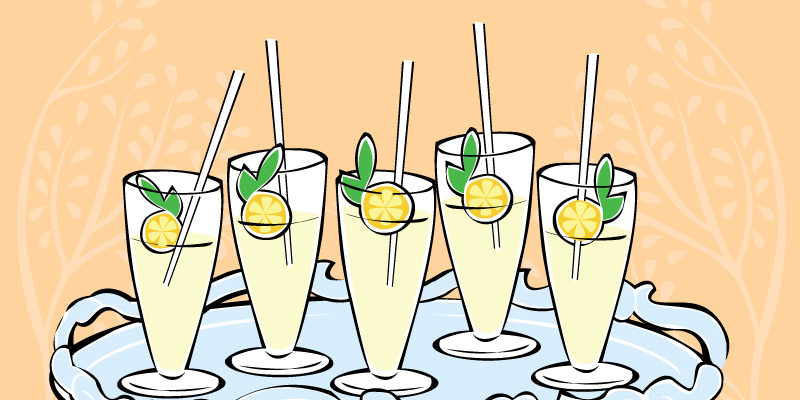Before New York had the Manhattan or Boston had the Ward 8, San Francisco had the Pisco Punch. Born in the heyday of the California Gold Rush at the Bank Exchange Saloon, it was perfected by Duncan Nicol, a Scots bartender since eulogized by historian Herbert Asbury as “second only to Professor Jerry Thomas.”
For a city whose existence was negligible prior to 1848, San Francisco blossomed into the Paris of the West in the next few decades. Nestled along the Pacific Ocean, it became an incandescent cultural jewel to rival New York. The city flourished, thanks to the hordes of men fueled by dreams of El Dorado and the steady streams of sifted gold that lined their pockets. The Bank Exchange Saloon opened its doors in 1853 and quickly became an institution. No Barbary Coast dive was this; by the time Nicol took it over in the 1880s, the Exchange was a stomping ground for San Francisco’s political and literary elite; a gentleman’s saloon.
Pisco itself was exported from Peru up to San Francisco well before gold was discovered at Sutter’s Mill. The concept of punch was something brought back by the British from India, a drink made from exotic ingredients to help prevent scurvy on the high seas. But in the City of Saint Francis, Nicol elevated the punch to an art form and was almost single-handedly the conduit through which America was first introduced to Pisco.
The virtues and potency (a limit of two per customer) of Nicol’s Pisco Punch were extolled by writers of the day. Mark Twain was fond of drinking the stuff as he swapped tales with a local fireman, the real life Tom Sawyer. Bret Harte, who fictionalized the miner’s life in his short stories, was a Bank Exchange regular. Even Rudyard Kipling drank Nicol’s brew, and forever committed it to the collective psyche of drinks enthusiasts the world over in his book, “From Sea to Sea.”
Theories of the punch’s contents were bandied around. Rivals sought to discover its formula, but to no avail. Like a true master, Nicol kept his secrets to himself. The enigmatic drink was prepared well out of view, pre-mixed in batches by the reticent Scotsman. Even Kipling had thoughts on the matter. He guessed the recipe contained “compounded of the shavings of cherub’s wings, the glory of a tropical dawn, the red clouds of sunset and the fragments of lost epics by dead masters.” In an age when fortunes were made and lost in the foothills of the Sierras, Nicol had struck gold of a more liquid variety. His concoction was a runaway success, a San Francisco icon, and the most famous libation to come out of that side of the Mississippi River.
Nicol served up Pisco Punch to thirsty travelers at the Bank Exchange until the bar, which had survived both the Great Quake of 1906 and subsequent fires, was forced out of business in 1919 by Prohibition. And although many implored him to share his recipe, Nicol kept mum. To make matters worse, Nicol didn’t live to see the repeal of Prohibition. For many years, the how-to for his wonderful punch was thought to have died with him.
Many eulogized the drink. The founder of The New Yorker, Harold Ross, wrote in May 1937, “In the old days in San Francisco there was a famous drink called Pisco Punch… which (as served in S.F.) used to taste like lemonade but had a kick like vodka, or worse.” Twenty years later, epicure Lucius Beebe wrote of the “ambrosial legend,” reminiscing about that bygone punch of punches. Finally, in 1973, a breakthrough. The California History Society Quarterly published a recipe copied from the Exchange’s last manager, which lists pisco, lemon juice, water, and pineapple-flavored gum syrup among its ingredients. In the years since it first disappeared, many believed that gum arabic, the natural gum made of the hardened sap of acacia trees, was Nicol’s secret ingredient, but a second school of thought has cropped up, expounded by Guillermo Toro-Lira in his book “Wings of Cherubs.” Rather than gum, it’s thought that a coca-infused (read: cocaine) tonic wine gave Nicol’s potion its heady kick.
Today, Nicol’s gift to the world of booze is going strong, thanks to the rise of craft cocktailing and the renewed interest in pre-Prohibition drinks. The Pisco Punch is an outstanding cocktail, and though it may not pack the same punch it did when Nicol was behind the bar, rest assured; you’ll still be feeling pretty good after knocking back a few.
How to Make Pisco Punch:
Ingredients:
- 2 ounces pisco
- 1 ounce lemon juice
- 1/2 ounce simple syrup
- 1/2 ounce pineapple juice
Note: the original recipe calls for pineapple gum syrup. You can substitute ¾ ounce of pineapple gum for the pineapple juice and simple syrup.
Directions:
Combine all ingredients together in a cocktail shaker. Add ice and shake vigorously. Strain into a chilled coupe. Garnish with a pineapple wedge and enjoy.

